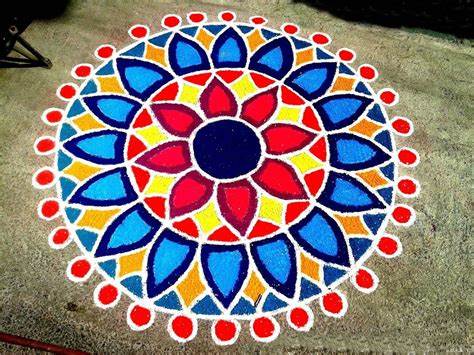The earliest form of Rangoli was created using rice flour, which was mixed with water to form a paste that was used to make patterns on the floor. Over time, the art form evolved, and new materials like coloured sand, flowers, and other natural substances were used to create more intricate designs. Rangoli is mentioned in ancient Indian scriptures like the Ramayana and the Mahabharata. In the Ramayana, it is said that Sita created a Rangoli using coloured powder to welcome Lord Rama back to Ayodhya after his 14-year exile. In the Mahabharata, it is said that Draupadi created a Rangoli using flowers to please Lord Krishna. Unlike in the past, it is now not only a craft for decorating the floor and wall; it is now being used to decorate several showpieces to attract the eyes of the viewers. These alponas can be drawn out in earthen planters, earthen plates as wall show pieces, pots, brass plates for table decorations, wall hangings, wooden platforms and of course for floor decorations. Alpona itself can much more be beautified with placing flowers, diyas, candles, and other beautifying objects on it which creates a more rejuvenating and auspicious atmosphere wherever it is made out. Traditional Materials ● Rice flour: Rice flour is the most common material used in traditional Rangoli. It is mixed with water to form a paste that is used to create patterns on the floor. Turmeric, vermillion, and other natural substances: Turmeric and vermillion are used to add colour to the rice flour paste. Other natural substances like flowers, petals, and leaves are also used to enhance the beauty of the Rangoli. Contemporary Materials ● Coloured powder: Coloured powder is used to create bright and colourful patterns in contemporary Rangoli. It is available in a variety of colours and can be easily spread on the floor. ● Coloured sand: Coloured sand is used to create intricate patterns in contemporary Rangoli. It is available in a variety of colours and can be easily spread on the floor. ● Stones and glitter: Stones and glitter are used to add a three-dimensional effect to contemporary Rangoli. They are usually used in 3D Rangoli and can be arranged to create beautiful patterns. Techniques Used In Rangoli The techniques used in Rangoli vary depending on the type of Rangoli being created. Traditional Rangoli is usually created freehand, while contemporary Rangoli is created using stencils and other tools. Traditional Techniques ● Freehand: Freehand is the most common technique used in traditional Rangoli. It involves creating patterns on the floor using bare hands and a rice flour paste. ● Stencil: Stencil is also used in traditional Rangoli. Pre-designed stencils are used to create patterns on the floor. Contemporary Techniques ● Stencil: Stencil is the most common technique used in contemporary Rangoli. Pre-designed stencils are used to create patterns on the floor. ● Freehand: Freehand is also used in contemporary Rangoli, but it is not as common as stencil. Experienced artists use their hands to create patterns on the floor.

